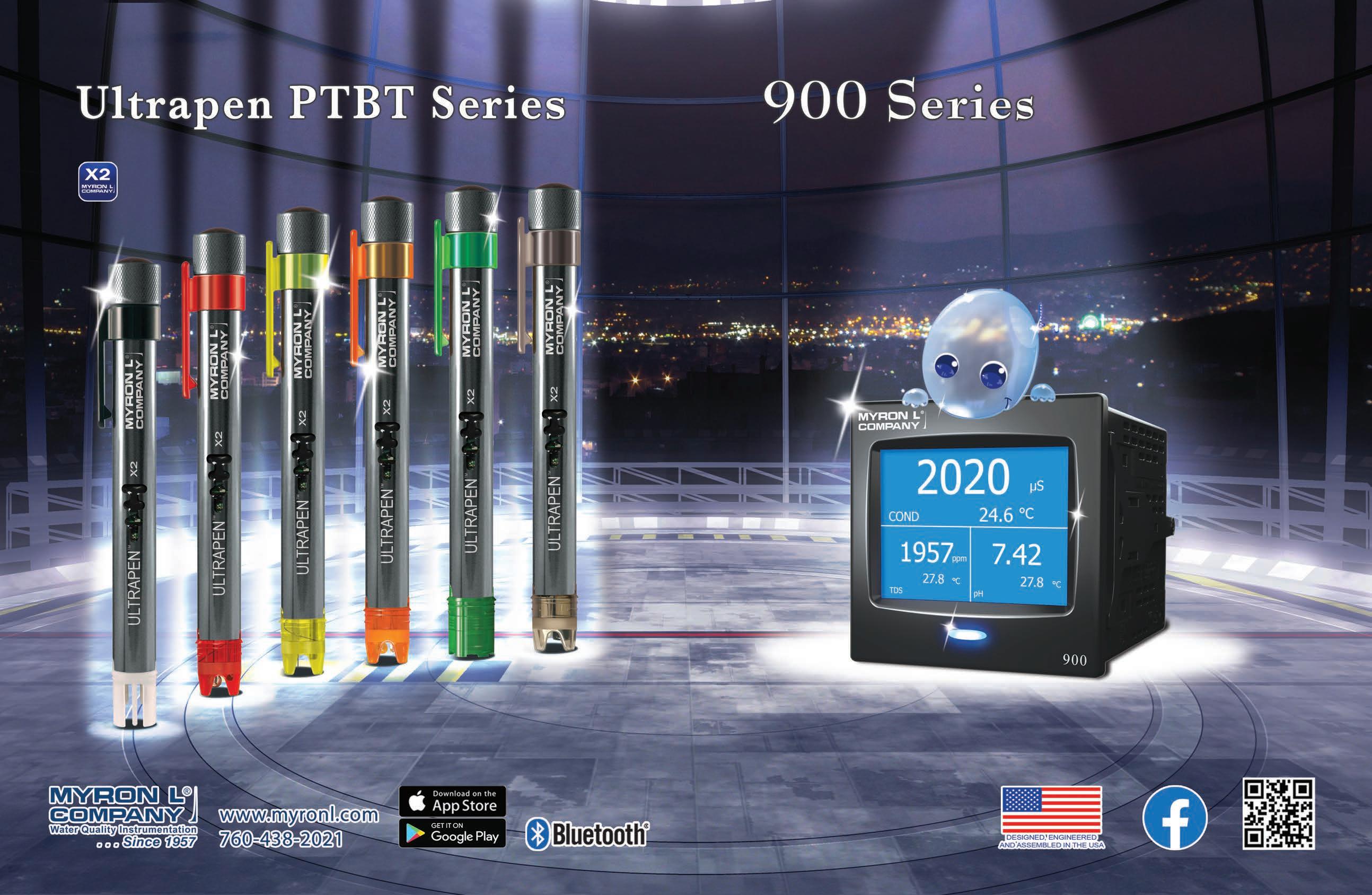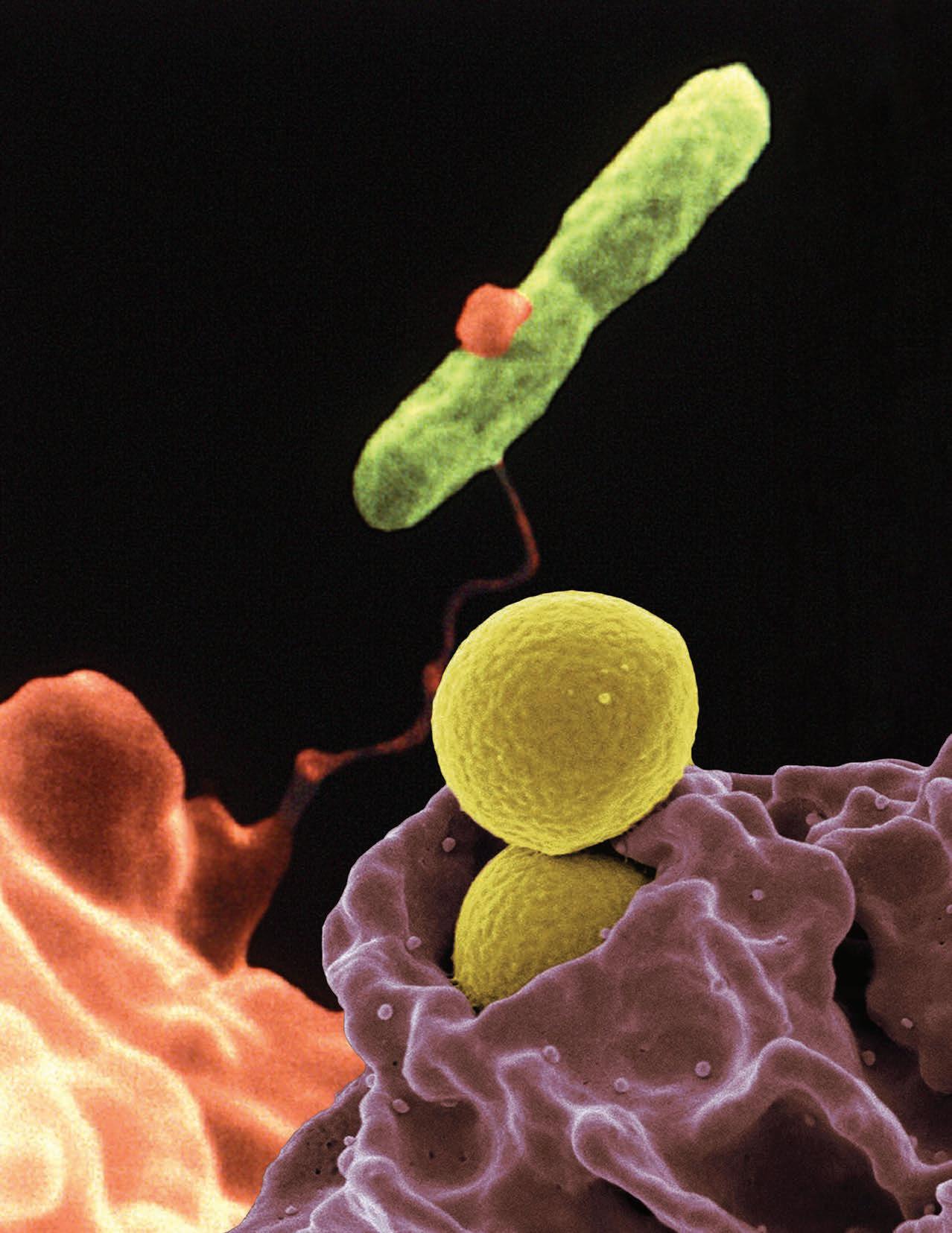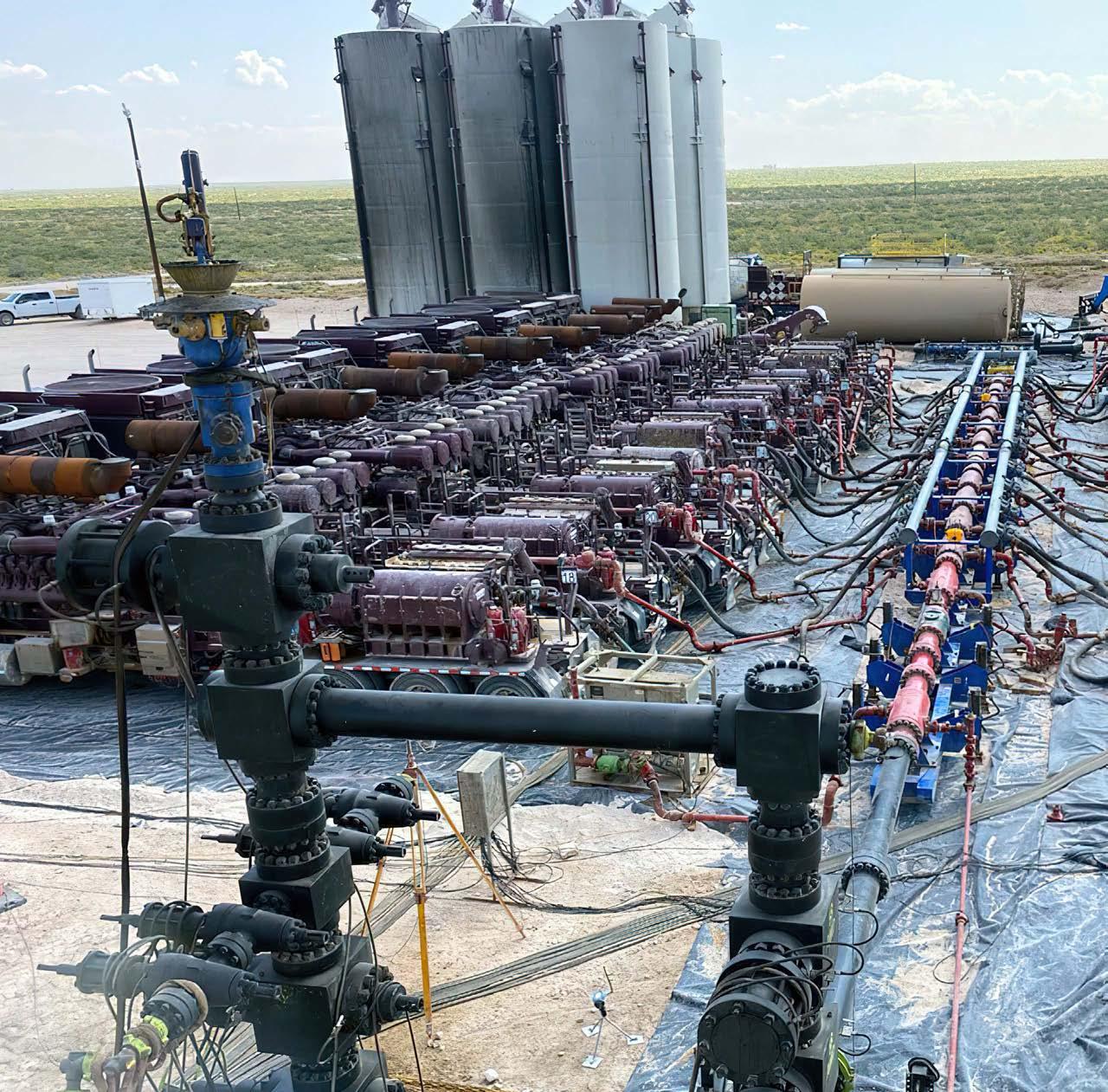
37 minute read
Part 1: How Does Water Sustainability Impact Oil and Gas Water Treatment?
Colin Frayne, CSci, CChem, CEnv, FRSC, CWT, Aquassurance, Inc.; and Barry B. Ekstrand, P.E., Finoric LLC
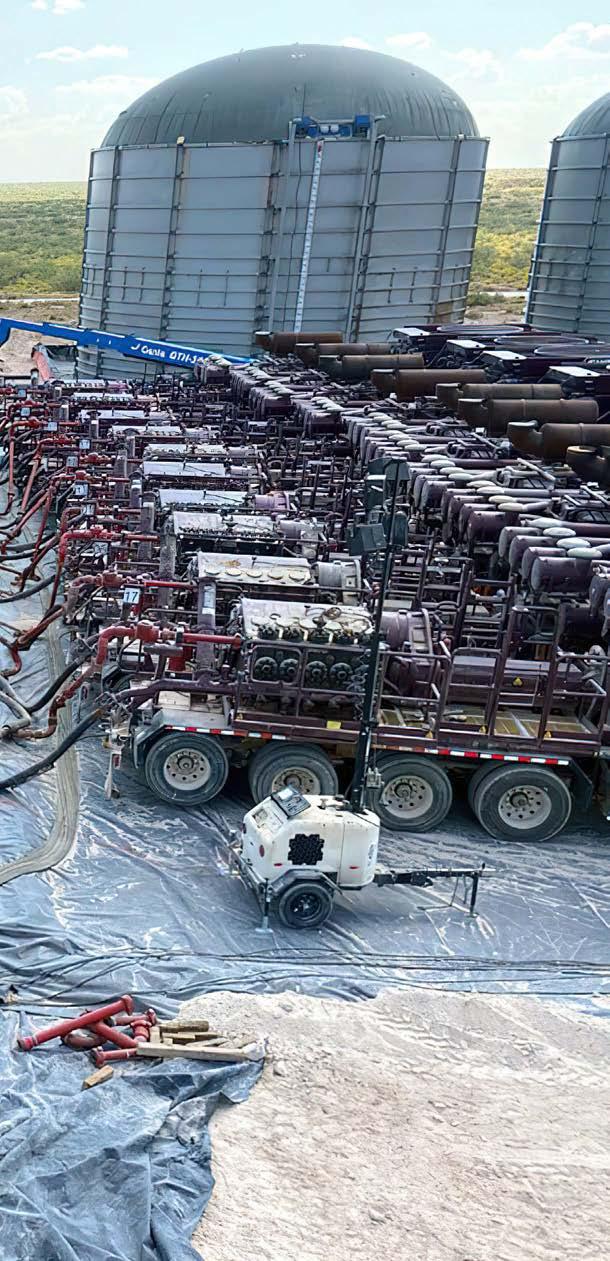
Editor’s note: The authors originally developed this two-part article series as a white paper in collaboration with the oil and gas performance chemicals and services company Finoric LLC of Beasley, Texas. Part 1 primarily looks back from historical practices to the current day, where less thought was given to the scaling tendencies of reinjected (and usually diluted) recycled brines, and the focus was (and currently still is) mostly on new well completion and fracture fluid chemistries. Part 2 primarily looks forward to an expansion of remedial stimulation of existing producing wells, and a future focus on the expansion of production brines and production chemistry work.
This article series examines hydraulic fracturing in oilfields for achieving higher yields of oil and natural gas. There can be different views on the spelling of the shortened term for “fracturing and fracture.” The generally accepted abbreviation for “hydraulic fracture” or “fracturing” is “frac.” Fracturing can be abbreviated as “frac’ing” or “fracing.” However, sometimes this term is referred to as “frack” or “fracking.” That said, generally those in the oil and gas industry will use the first spellings when referring to this practice because “frac” is short for fracture. For the purposes of these articles, we will use the spellings of “frac” and “frac’ing” to refer to “fracturing.”
Abstract As a result of global population growth and an increased demand for energy and good quality water, the demand and supply positions for vital resources (especially water) varies considerably from country to country; but globally, freshwater withdrawals have increased six-fold over the last 100 years, and we all face an uncertain future due to critical worldwide water shortages and quality problems. In view of this crisis, this article series focuses on the oil and gas industry and its relatively large usage of water (e.g., for hydraulic fracturing fluids). It provides an overview on the types of standard water treatment separation processes available to implement the three Rs (i.e., Reuse, Recycle, and Reclaim) and aims to further reduce water consumption. Additionally, these articles provide some guidance notes on the benefits, limitations, and application of phosphonates, polymers, and other waterside chemical inhibitors and performance additives for selection by water treatment practitioners when confronted with more complex brine water chemistry.
Increased Demand for Energy and Good Quality Water Demographics tell us the number of people in the world increased more than four-fold during the 20th century, and so we may wonder what humanity’s future will look like (1). Unfortunately, beyond trends on future population growth, it remains extremely difficult to predict with much certainty the future of the world’s inhabitants. However, it is clear that the threads of mankind are closely intertwined with our impact on the natural environment; pandemics and other catastrophic events; fertility rates; and access to space, food, health services, education, and other resources. Therefore, it seems very unlikely that mankind’s demand for energy and good quality water will ever diminish.
In spite of the politics of climate change and activist calls for a reduction in the world’s dependence on fossil fuels—in favor of nuclear energy, solar and wind power, and other sustainable energy sources—global demand for crude oil (including biofuels) has in recent years been continuously climbing by approximately 10% per year. In 2006, daily global crude oil demand was 85.3 million barrels per day (MMB/D). At the time of the writing of this article in mid-2022, daily global crude oil demand was estimated to be 96.5 MMB/D, and the estimate for 2026 is 104.1 MMB/D. The only decrease in demand in recent history was in 2020, when usage dropped to 91 MMBD due to the economic and mobility impacts of widespread shutdowns across the world due to the COVID-19 pandemic (2). Specific to the United States, the Energy Information Administration (EIA) estimates that about 2.70 billion barrels of crude oil were produced directly from shale (tight) oil resources in 2020. This is equivalent to about 7.37 MMB/D and equal to about 65% of the total U.S. crude oil production, which shows how important unconventional resource development of shale oil (and gas) production is to the total annual output of U.S. hydrocarbon production (3).
The demand and supply positions for vital water resources vary considerably from country to country, but globally, freshwater withdrawals for agriculture, industry, and domestic/municipal use have increased six-fold over the last 100 years or so, with a sharp rise from the 1950s onward. However, since 2000, the annual increase in global water withdrawals appears to be plateauing, or at least decelerating, at around 4 trillion cubic meters per year (nb: 1 cubic meter = 264.172 U.S .gallons). However, it is clear that most conventional renewable water resources are declining in both output and quality in many countries as a result of population increases. Today, water shortages are affecting more than 3 billion people, and the amount of fresh water available per person has plunged by a fifth over the last two decades (4).
In the United States, water use in 2015 was estimated to be about 322 billion gallons per day (Bgal/d), which was 9% less than in 2010. The 2015 estimates put total withdrawals at the lowest level since before 1970, following the same overall trend of decreasing total withdrawals observed from 2005 to 2010 (5). This lower (i.e., improved) water withdrawal position is likely due to significant changes in agricultural and horticultural irrigation practices, including use of surface-and subsurface drip irrigation techniques.
Additionally, to reduce demands on the fresh water use, we see water/wastewater recovery, recycling, reinjection, purple pipes, and other water reuse techniques being increasingly practiced by municipalities and industries of all types. We are also seeing an increase in the commercial application of a wide range of modern water and wastewater treatment technologies that barely existed 30 or 40 years ago—particularly those processes that incorporate polymeric membranes, such as wastewater membrane bioreactors (MBR), seawater reverse osmosis (SWRO), and electrochemical deionization (EDI).
Relationship Between Hydraulic Fracturing and Water Hydraulic fracturing treatments aim to stimulate (increase the productivity) of low-permeability oil and gas wells by creating a propped fracture (a crack in the reservoir rock) extending deep into the reservoir from the wellbore. The fracture is created by pumping a hydraulic fluid at high pressures that cause the reservoir rock to fail, creating the fracture at the wellbore and then extending it into the reservoir. Sand or other propping agents are pumped into the fracture during the frac treatment, which holds the fracture slightly open after the frac job is completed. The resulting propped fracture is highly conductive, which allows reservoir fluids to flow into the wellbore at much higher rates than those of nonstimulated wells.
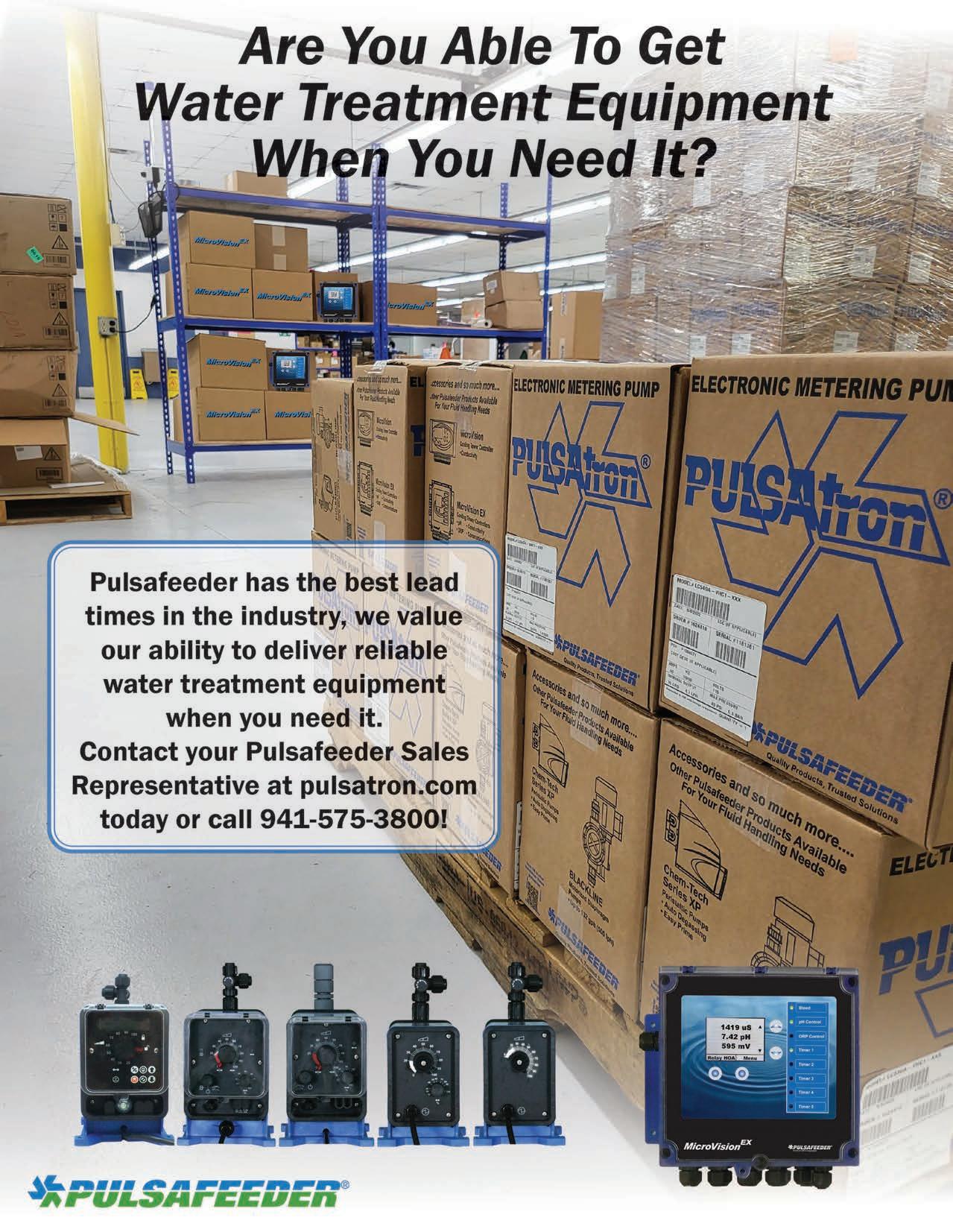
The first frac job was pumped in 1947, and the early frac jobs were just a few hundred gallons in volume—a miniscule size by today’s standards. Just about every fluid imaginable has been used as the base fluid for a frac job, with napalm (gelled gasoline) being used on the first job, and also including crude oil, gelled oils, inorganic and organic acids, acid/water/oil emulsions, and foams, but the vast majority of frac jobs have used water—both fresh and brine, and both gelled and ungelled—as the base fluid. Not surprisingly, water brings a number of benefits over the other alternatives:
Water is benign and much safer to work with. Water is generally far more plentiful and available. Water usually has a much lower cost. Water is a great solvent that can carry multiple desired chemistries into the reservoir. There are a larger variety of available chemical additives that allow for easier adjustment of the waterbased frac fluid physical properties.
A fundamental design concern for frac treatments is compatibility between the frac fluid and the reservoir rock mineralogy and reservoir fluids. For example, in the presence of fresh (non-brine) water, smectite and mixedlayer clays will swell, while illite and kaolinite clays will break apart and migrate. The result in each of these cases can be a significant reduction in reservoir permeability due to plugging of pore throats in the rock caused by these physical changes in clay structure. Creating an artificial brine by adding an appropriate amount of a compatible salt (such as potassium chloride or a “KCl substitute,” such as choline chloride) to the fresh water will reduce or eliminate these effects. Other potential concerns include dissolution and re-precipitation of iron compounds, precipitation of asphaltic sludge from the oil, deposition of paraffin (wax) from the oil, creation of emulsions with the oil, and creation of water blocks in the reservoir. Suffice it to say that ensuring compatibility between the water-based frac fluid and the reservoir is critical. Intuitively, the ideal frac fluid would be made with a base fluid that is from (or mimics the composition of) the native reservoir water.
For many years, each frac job was designed with the specific well, formation rock properties, and other reservoir parameters in mind. This effort, along with a continual focus on maximizing the commercial value of the frac treatments, led to treatment volumes growing significantly over time. By 1980, frac jobs using more than 100,000 gallons were common, and very large treatments of~1 million gallons were sometimes occurring. Treatment volumes continued to grow throughout the 1980s and 1990s and into the early 2000s, with most frac designs incorporating relatively expensive high-viscosity fluid systems. These fluid systems were designed to suspend the frac sand as it was being pumped so that it would not settle out, but rather, would be carried far into the fracture so that the fracture would be propped open deep into the reservoir.
By the mid-2000s, oil and gas shale drilling was growing rapidly. Shale frac designs deviated from the historic frac design approach in several significant ways:
The viscosity of the base fluid would not be raised, so no viscosifiers/gelling agents were added. Because viscosity was low, enhanced sand suspension was lost. As a result, the frac jobs needed to be pumped in high turbulent flow (i.e., at much higher pumping flow rates). Use of polyacrylamide-based friction reducers (FR) to reduce the treating pressures of the frac jobs grew exponentially. The size of the frac sand being pumped became smaller due to lower terminal settling velocity and ability to carry it farther into the fracture before settling out. Well completions increasingly moved into a
“manufacturing mode” where the same frac design was pumped on each job. Operational efficiency (amount of time to pump each frac job) became a primary focus. Correlations were seen between larger frac job sizes and higher well productivity, leading to another large uptick in treatment volumes.
Today, shale frac job sizes have grown, along with wellbore lengths and number of frac stages per well, such that tens of millions of gallons of water may be used for the completion of the wells on a single drilling pad. As the demand for larger and larger volumes of water grew, a number of issues became problematic and critical:
In some areas, access to the necessary volumes for the frac jobs became increasingly difficult to find. The cost of sourcing these large volumes of fresh water became significantly large. The cost of disposing of these large volumes of water
during flowback after the frac job—always a concern in the past—now became extremely high. As a result, recycling and reuse of the previously used frac water and produced water became a necessity. Rising TDS levels resulting from recycling may cause a reduction in efficacy of certain frac fluid components, such as FR. In some cases, dilution with additional fresh water to reduce the TDS below a particular threshold may solve the issue, while in other cases a change in FR chemistry may be required. Recycling and reusing frac water and produced water ultimately means dealing with all of the challenges of effective water treatment: the need to clean up brine water containing high TDS and high TSS, at times along with dissolved iron, residual oil, residual chemicals, and/or contamination with bacteria.
The number and size of frac jobs pumped annually is expected to continue to grow in the coming years, which means that the water volumes required to make up the frac fluid will continue to increase. Effective treatment and cleaning of recycled frac and produced water for reuse in frac treatments will not only remain a critical aspect of the frac job execution for years to come, but it will be a necessity and required enabler for economic and social viability of the drilling and completion of new oil and gas wells.
Wastewater Recycling Given that the process of unconventional development, including hydraulic fracturing of shale for oil and gas production in the United States, is equal to about 65% of total U.S. output, there is no doubt that we are in a golden age for shale plays. The rise of North American shale oil and gas production has brought game changing predictions about supply and demand, and with it, key players with technologies and expertise to unlock previously inaccessible shale resources (6). The Independent Petroleum Association of America (IPAA) indicates that hydraulic fracturing has been safely used in the United States since 1947 and that more than 1.7 million U.S. wells have been completed using the frac’ing process. Indeed, the U.S. Environmental Protection Agency (EPA) has stated that unconventional oil and natural gas plays a key role in our nation’s clean energy future (7).
Ask for Legiolert and deliver more accurate Legionella results
The Legiolert® Test is a more
accurate culture test for Legionella pneumophila

Spread plate methods are notoriously inaccurate, with up to tenfold variability in results for the same sample.1 Multiple peer-reviewed studies have confirmed that the Legiolert Test provides more accurate and consistent results.2–5
See the difference the Legiolert Test can make at idexx.com/legiolertdifference.
References 1. Lucas CE, Taylor TH Jr, Fields BS. Accuracy and precision of Legionella isolation by US laboratories in the ELITE program pilot study. Water Res. 2011;45(15):4428–4436. doi:10.1016/j.watres.2011.05.030 2. Petrisek R, Hall J. Evaluation of a most probable number method for the enumeration of Legionella pneumophila from North American potable and nonpotable water samples. J Water Health. 2018;16(1):25–33. doi:10.2166/wh.2017.118 3. Spies K, Pleischl S, Lange B, et al. Comparison of the Legiolert/Quanti-Tray MPN test for the enumeration of Legionella pneumophila from potable water samples with the German regulatory requirements methods ISO 11731-2 and ISO 11731. Int J Hyg Environ Health. 2018;221(7):1047–1053.doi:10.1016/j.ijheh.2018.07.006 4. Sartory DP, Spies K, Lange B, Schneider S, Langer B. Evaluation of a most probable number method for the enumeration of Legionella pneumophila from potable and related water samples. Lett Appl Microbiol. 2017;64(4):271–275. doi:10.1111/lam.12719 5. Barrette I. Comparison of Legiolert and a conventional culture method for detection of Legionella pneumophila from cooling towers in Québec. J AOAC Int. 2019;102(4):1235–1240. doi:10.5740/jaoacint.18-0245
However, oil and gas production obtained from shale plays uses a lot of water! Depending on the play, a well may require from 2 to 5 million gallons or more before completion, of which 80 to 90% is used for fracturing and only 10 to 20% will be typically required for drilling and other purposes (8). That is a lot of frac wastewater for potential disposal, and although the EPA advises us there are approximately 144,000 underground injection (disposal) wells for produced water (PW) disposal, some practices can possibly create problems. If injection volumes into disposal wells result in injection pressures that exceed the frac gradient of the injection formation, microfractures can be created that grow vertically into other formations that lie above or below the injection zone.
For shallow injection wells, this could include formations that contain potable groundwater, resulting in risks of contamination to shallow groundwater aquifers. Another potential effect of overinjection is the creation of localized micro earthquakes being felt at the surface. With these potential negative impacts, it is clear that effective management of produced wastewater is critically important to ensure positive environmental, social, and governance (ESG) impacts result instead. Adequate numbers of local injection wells must exist and be available to ensure that wastewater disposal injection pressures stay well below formation frac gradients.
Additionally, note that during the sequential oil or gas recovery process, PW emerges as an associated byproduct, containing mainly formation water (FW) and a small portion of frac fluids as flowback. As an example, in the Permian Basin, the PW-to-oil ratio (PWOR) of shale wells is around three, and for all U.S. plays on average, more than 90% of the PW is naturally occurring FW and connate/interstitial water. That is a lot of frac wastewater for potential disposal, and although the EPA advises us there are approximately 180,000 underground injection wells for PW injection, some practices can possibly create problems.
Currently, the preferred method for disposal of PW is through permitted Class II water injection wells, of which 20% are saltwater disposal wells and 80% are wells that are enhanced oil recovery (EOR) injection wells. These EOR injection wells include waterflood injection wells (i.e., injection of water to drive oil in the reservoir to producing wells), steam-injection wells (to thermally thin and drive viscous oils), and water alternating gas (WAG) injection wells or simultaneous water and gas (SWAG) injections wells (both are techniques to improve the sweep efficiency of waterfloods or gas floods).
The alternative to disposal of frac fluids is wastewater capture, treatment, and reuse—for new frac jobs, irrigation, cooling water, or other purposes. This recycling practice has been growing year over year in output volumes. However, in view of the continuing global importance of oil and gas, produced by both conventional and unconventional means, and the need to move closer to a water-secure and net-zero world, it is important during new well development and production to aim to use even less fresh water and associated chemistries. Thus, in the oil and gas industry, it is also necessary to recover, treat, and reuse as much PW, FW, and flowback frac fluids and blends as possible.
The Three R’s of Water: Reuse, Recycle, Reclaim
“Water, Water, Everywhere, Nor Any Drop to Drink”
–Rime of the Ancient Mariner, by Coleridge
This water reuse, recycle, reclaim focus is of significant business interest to both large and small service companies in the oil and gas and water treatment chemical/ equipment fields. These firms tend to operate in several specialist niche sectors and geographies within the global oil and gas support services market and may offer separation processes, such as oil/water separation, evaporative water recovery, or wastewater clarification. Specific performance chemical “packages” may be required, to perhaps include demulsifiers (treaters, droppers, and hybrids, etc. to destabilize/ break/ flocculate/ coalesce water-in-oil emulsions), reverse demulsifiers (to break oil-in-water emulsions), reverse emulsion breakers (REB) (to break complex water-in-oil-in-water [W/O/W] emulsions), as well as gas hydrate inhibitors, surfactants, antifoams, coagulants, flocculants, precipitants, piping corrosion inhibitors, and antiscalents.
Previously, chemistries for slick water generation, proppant support, and some limited water treatment for scale, corrosion, microbiological, and/or general fouling
inhibition were typically primarily focused on treating a wide range of fresh waters, with perhaps less emphasis being given to treating the scaling tendencies of reinjected (and usually diluted) recycled brines. This focus is changing, and more applications expertise is often now available for managing the native reservoir brines that will be produced in the future.
Service companies offer expertise in working with their arsenals of complex (and now usually more eco-friendly) chemistries and formulations in order to modify produced brines for reuse as frac fluid bases. Some service firms may also be active with remedial stimulation of existing producing wells, which traditionally has been a smaller focus for business development opportunities but is expected to grow in the future. Similarly, growth is also expected for novel or “green” production chemistries, and their application in optimizing repurposed brines and other industrial waters for reuse. However, consideration of the formation rock surfaces and mineralogy is very important when formulating new chemical treatment products.
Nearly everything injected into a well is foreign to it, so there is a need to fully understand the likely impact of fluid constituents on the rock and its associated environment. This means that a comprehensive analysis of all fluid interactions with the formation rock and its environment is the first need. It is well understood that produced water quality varies from play to play, and no single technology exists that is best for treating all produced waters in all operating areas, such that it can be recovered for blending or direct reuse. Additionally, operators understand that to produce a laboratory analysis of water quality and contaminants is not particularly difficult, but its interpretation and what this ultimately means in terms of slick water and other frac fluid chemistries can be challenging. Here are some considerations:
What is the best way to implement any specific frac job using fresh or recycled water? What types of processes may eventually be required to treat the large volumes of produced water? How can the answers to these questions help to implement the concepts of Reuse, Recycle, and Reclaim?
What chemicals are present in the frac fluid? Frac fluids potentially contain a wide range of additive chemistry products that vary in composition from play to play, such that each additive is itself a formulation of performance chemistries, collectively providing a task-specific component of an overall fracturing fluid program. Beyond the addition of primary ingredients,* the total formulated performance additive packs may comprise perhaps 0.3 to 0.75% by volume (3,000 to 7,500 milligrams per liter [mg/L], or ppm) of the base frac fluid.
Chemistry additive components for hydraulic fracturing fluids may include some or all of the following materials:
1. Surfactant: Used to reduce oil/water surface tension.
Example: a poly(ethylene glycol) methyl ether (PEG methyl ether) or similar.
2. Gelling agent: Typically, guar gum or a derivatized guar-based polymer such as hydroxypropyl guar (HPG) or carboxymethyl hydroxypropyl guar (CMHPG). Other polymers that may be used include hydroxyethyl cellulose (HEC) and xanthan gum. In all of these cases, the purpose of the gelling agent is to increase the frac fluid viscosity and help support and carry the proppant. Nonderivatized guar gum is used in the vast majority of water-based frac jobs requiring significant viscosity. Other types of gelling agents include those for oil-based frac fluids, such as phosphate ester surfactants (e.g., dialkyl phosphoric ester) or phosphorus-free gelling agents, and may be used to recover or enhance production output.
3. Gelling agent cross-linker: Typically, zirconium, titanium, or borate-based. These create or improve the polymer network and system viscosity.
Uncrosslinked guar-based polymers (commonly called “linear gels”) may become thinner with an increase in temperature, so a cross-linker can aid viscosity stabilization.n* For example, 0.2 to 2.0% of potassium chloride (KCl) or substitute in the base water; 5 to 15% or so of fracturing acid employed (usually hydrochloric acid [HCl]); and the many tons of varying size, shape, and strength of crystalline silica sands or ceramic proppant (of typically, 0.1 to 0.2 mm diameter).
4. Slick water friction-reducer (FR): Fracturing fluids need sufficient viscosity to create and open a fracture but must also have a low friction coefficient. Linear
gels typically generate 12 to 18 centipoises (cPs) of viscosity, where crosslinked gels can generate viscosities of 500 to 4,000 cPs or more. However, for many unconventional shale formations, low viscosities of only 1 to 5 cPs may be all that is required and desired, although in some cases a high-viscosity friction reducer (HVFR) may be used to generate viscosities in the 8 to 13cPs range. In either case, FR or HVFR yield relatively low frac fluid viscosities. Because shale frac designs show a preference for low viscosities, the terminal settling velocity of the frac sand particles is relatively high and results in the frac sand settling out quickly in the typical shale frac design.
Since it is desirable to achieve a higher propped frac length (that is, to pump the frac sand grains farther into the fracture from the wellbore before settling out), the frac fluid pumping rate must be very high (typically 80 to 140 U.S. barrels per minute [bpm]) on shale frac jobs in order to achieve adequate propped frac length. At these pumping rates, friction pressure becomes high, and friction reducers are necessary to lower the frac job pumping pressure. In some cases, a lightly gelled linear guar is used, but FR and HVFR are generally preferred because they are able to lower the friction pressure to a greater degree at a lower cost. FR and HVFR can lower the friction pressure by 60 to 80%, depending on the water salinity and other chemical presence. FR and HVFR chemistry are typically based on polyacrylamide (PAM) or PAM/AM copolymers.
5. Live breaker: Ammonium persulfate [(NH4)2S2O8] and other oxidizers break the polymer network and reduce the viscosity of a fracturing fluid (ideally) following the end of each frac stage to help flow the well back. The breaker oxidation reaction speeds up significantly with increased temperature and increased breaker concentrations, so designing an optimized breaker schedule for the specifics of each frac job is desirable.
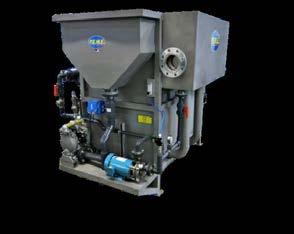
6. Encapsulated breaker: To ensure that the breaker does not reduce frac fluid viscosity too early, an encapsulated breaker can be used. An encapsulated breaker consists of a time-release coating or encapsulation of ammonium persulfate [(NH4)2S2O8] that results in a slower release of the oxidizing breaker. This allows the designed concentration of oxidizer to reach the tip of the fracture at full strength before releasing, so the entire fracture sees a uniform viscosity degradation after completion of the frac job.
7. Corrosion inhibitor: Typically, long-chain ethoxylated fatty acid alkylamine film formers are used to reduce the corrosion resulting from acids being pumped down steel casing and tubing (pipes) that make up oil and gas wells.
8. Scale inhibitor: Typically, a copolymer and/ or a standard phosphonate, or perhaps a diethylenetriamine (DETA) phosphonate, are deemed suitable for management of alkaline earth salts and scales such as calcium carbonate, barium sulfate, and others.
9. Iron inhibitor: Perhaps control here might also be served by the scale inhibitor/dispersant, or via a watersoluble ethylenediaminetetraacetic acid (EDTA), gluconate, terpolymer, or alternatively, by imidazoline film adsorption. In combination with pH control
Wastewater Treatment: DAF Innovation
US Patents #8431022 & #9962631
The T²-Max® DAF
Thickener handles high mixed solids flows without sacrificing separation performance.
The HD²XLRator® DAF
design encompasses the full array of newly advanced technological innovations.
The Nx²JEM® DAF
utilizes key hydraulic flow and laminar engineering principals to achieve high volume separation.
Contact PEWE at: 360-798-9268 www.pewe-usa.com
(keeping the solution pH at less than 5), a viable approach can be to use iron inhibitors to prevent oxidation of ferrous iron (Fe+2) to its ferric (Fe+3) form. Ferrous iron does not precipitate below a pH of 8.5, but ferric iron forms precipitates at pH of 3.5 or above.
10. pH buffer: Used to control the pH of a solution.
Perhaps a simple chemistry such as hydronium ion/ conjugate base (e.g., a citric acid-phosphate mix), or perhaps the use of a methane/ethane sulfonic acid chemistry.
11. Biocide: Used to kill bacteria that is present or can grow in a surface tank and systems, or downhole in producing wells. Typically, a non-oxidizer gluteraldehyde, quat, or isothiazoline blend.
12. Demulsifier: Perhaps an EO block copolymer, ethoxylated alkylphenol, or di-epoxide (all of appropriate hydrophilic-lipophilic balance, HLB), in, for example, a methanol or a heavy aromatic naphtha (HAN) solvent. Water Sources As discussed earlier, following frac jobs, produced water containing both formation water and flowback water is most seen, with the proportion of formation water increasing over time. It is common to find the amount of frac fluid volume recovered to be very low, with a significant amount of the injected volume being “lost” to uptake/absorption forms of inhibition and/or other mechanisms in the formation.
We know that produced formation waters are highly variable within and between shale formations. We also understand that sometimes, sampling problems and limitations of some analytical test methods can occur, which adds to problems to be solved.
Table A is an example of typical analytical ranges of some commonly found parameters in raw produced water samples. Table B also shows a produced water analysis, but this time with a review of analytical constituents and key saturation parameters, as calculated using French Creek ion association modeling software. Results are indicative of which contaminants, dissolved minerals, and potential downstream problems may need to be reviewed when treated
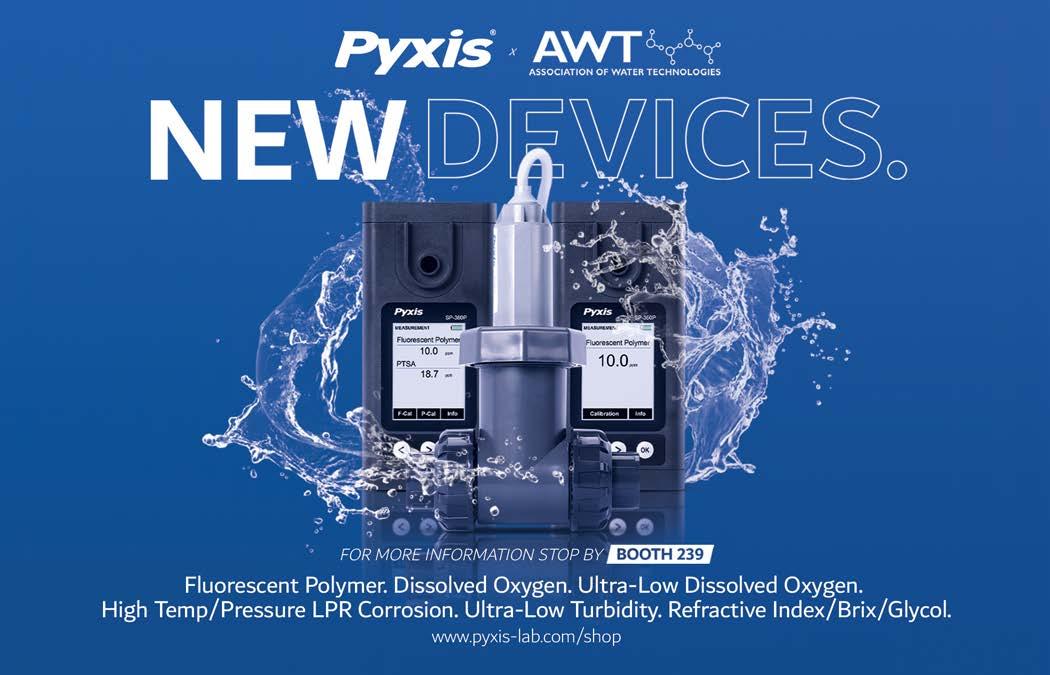
produced waters are reused as a frac fluid, or for other purposes, such as drilling, cooling, or irrigation water.
Note that inorganic and wet chemistry tests on produced waters can be affected by very high solids content and other shale matrix complexities. Few volatile organic compounds (VOCs) and semivolatile organic compounds (SVOCs) are regularly detected in produced formation waters. However, when they are seen, benzene, toluene, and xylenes (BTX) are the most common VOCs found, and phenols and pyridene are the most common SVOCs. Concentrations of barium and strontium salts tend to rise and fall but generally correlate with total dissolved solids (TDS) results. Chloride represents the most abundant anion. Concentrations of these various analytical parameters appear to increase with time following hydraulic fracturing activities and remain at high concentrations in the produced formation water from operating wells in each shale formation (9).
Table A: Example of Typical Analytical Ranges for Constituents of Produced Water Across Plays
Raw Produced Water Samples, Reflecting Typical Analytical Ranges of Some Commonly Found Parameters
Parameter
Units Range of Results pH — 4.0–7.0 Electrical conductivity µS/cm Not possible due to oil Calcium mg/L Ca 500–35,000 Magnesium mg/L Mg 500–4,500 Chloride mg/L Cl 20,000–165,000 Sodium (Na) mg/L Na 22,000–70,000 Potassium mg/L K 1,250–1,700 Strontium Mg/L Sr 60–2,400 Boron mg/L Bo 20–30 Barium mg/L 1–7 Iron mg/L Fe 0.5–35 Zinc mg/Zn 0–5 Total dissolved solids (TDS) mg/L 45,000–275,000 Turbidity NTU 80–250 Total suspended solids (TSS) Mg/L TSS 1,000–12,000
Treatment Considerations in Water Recycling Considering the current water recycling position, most recent research work, technical reports, and promotional documents essentially say the same thing: recycling oil and gas produced water for reuse in new frac operations or other water uses (e.g., irrigation, purple pipes, toilet flushing, drinking/potable) is a viable process and usefully saves fresh water, transport costs, and waste! The question then becomes one of identifying future uses of treated reclaimed water, and then adjusting one or more standard equipment treatment technologies or process trains (and selective water treatment chemistries) to precisely match needs. Going forward, a better understanding of the variabilities in production brines and matching them with appropriate performance chemistries will likely be a bigger focus.
Some useful related comments extracted from cited papers in this article and reports on this subject are provided in this section:
1. Ten years ago, ExxonMobil affiliate XTO Energy teamed up with a major oilfield services company to test the feasibility of reusing produced water for new frac’ing operations. Real-world tests confirmed that with minimal treatment, the fluid used in these wells could successfully fracture the rock and carry sand into the fractures to hold them open, even when based on 100% produced water, saving fresh water, money, and wasted truck trips (10).
2. According to the Texas Water Development Board, in areas of Texas where fresh water is scarce, the waterintensive nature of hydraulic fracturing could be a cause for concern. Some frac wells require 10 million gallons of water or more. Isn’t there a way to recycle and reuse this water? Frac fluids combine water with proprietary mixes of chemicals and are unsuitable for reuse without treatment. “There are chemicals, oil droplets, rock fragments, polymers and a bunch of gunk you need to get rid of,” noted Dr. Jean-Philippe
Nicot, senior research scientist with the Bureau of
Economic Geology at the University of Texas at
Austin. “Also, you may have collected chemicals that might not be compatible with the chemicals injected into the water for your frac operation, and therefore it might not work.” And because of its potential toxicity to waterborne organisms, frac water cannot simply be disposed of in surface waters (11).
Figure 1 (12) is an example of a produced water analytical constituents review. Note that the figure includes both graphs and tabular data.
Figure 1: Example of a produced water analytical constituents review.
SYSTEM IDENTIFICATION WATER CHEMISTRY
Sample 1 Lab Tech: Ernest Jack
Field Tech: Joseph Bear
Sample ID#: 669 ID 04201998
Sample Date: 03-20-2014 at 1436 Report Date: 03-20-2014
SCALE AND CORROSION POTENTIAL
CATIONS(mg/L) ANIONS(mg/L)
Calcium(as Ca) 6230 Chloride(as Cl) 45800
Magnesium(as Mg) 474.00 Sulfate(as SO4) 1860
Barium(as Ba) 0.00 Bromine(as Br) 0.00
Strontium(as Sr) 67.30 Acidity(as CaCO3) 49.78
Sodium(as Na) 22000 "M" Alkalinity(as CaCO3) 795.00
Potassium(as K) 1370 "P" Alkalinity(as CaCO3) 0.00
Lithium(as Li) 0.00 Silica(as Si) 0.00
Iron(as Fe) 0.600 Phosphate(as PO4) 0.00
Ammonia(as NH3) 0.00 H2S (as S) 0.00
Aluminum(as Al) 0.00 Fluoride(as F) 0.00
Manganese(as Mn) 0.700 Nitrate(as NO3) 0.00
Zinc(as Zn) 0.00 Boron(as B) 0.00
Lead(as Pb) 0.00
PARAMETERS
Temperature(oC) 20.00 Sample pH 7.45
Conductivity(umhos/cm) 76048 Sp.Gr.(g/mL) 1.000
Resistivity(megohm-cm) 1.31e-5 T.D.S.(mg/L) 77962
Temp. Calcite Anhydrite Gypsum Barite
Celestite Siderite Mackinawite (oC) CaCO3 CaSO4 CaSO4*2H2O BaSO4 SrSO4 FeCO3 FeS 21.00 3.80 0.0622 1.01 3.54 1.58 150.53 0.00 -0.0434 0.587 -29.94 0.422 -0.0901 0.00 -0.710 29.90 5.40 0.0875 1.01 4.40 1.46 124.45 0.00 -0.0646 0.572 -31.66 0.674 -0.0413 0.00 -0.721 38.80 7.22 0.112 1.07 22.52 1.38 104.64 0.00 -0.0908 0.573 -31.38 1.00 0.00197 0.00 -0.733 47.70 9.27 0.136 1.19 52.38 1.49 122.97 0.00 -0.123 0.579 -30.54 1.43 0.0413 0.00 -0.746 56.60 11.68 0.163 1.38 88.29 1.62 140.26 0.00 -0.165 0.582 -30.09 1.98 0.0796 0.00 -0.760 65.50 14.47 0.192 1.66 125.63 1.75 153.84 0.00 -0.218 0.582 -29.98 2.69 0.118 0.00 -0.775 74.40 17.67 0.225 2.06 161.12 1.87 164.72 0.00 -0.287 0.579 -30.19 3.58 0.156 0.00 -0.792 83.30 21.25 0.261 2.64 192.77 1.99 173.64 0.00 -0.373 0.574 -30.70 4.67 0.193 0.00 -0.810 92.20 25.21 0.301 3.47 219.78 2.09 181.17 0.00 -0.481 0.567 -31.51 5.97 0.230 0.00 -0.830 101.10 29.03 0.349 4.60 245.39 2.16 188.81 0.00 -0.624 0.550 -33.66 7.39 0.265 0.00 -0.860 110.00 33.49 0.399 6.30 264.52 2.25 194.85 0.00 -0.796 0.538 -35.25 9.08 0.295 0.00 -0.884 110.00 33.49 0.399 6.30 264.52 2.25 194.85 0.00 -0.796 0.538 -35.25 9.08 0.295 0.00 -0.884 Lbs per Lbs per Lbs per Lbs per Lbs per Lbs per Lbs per xSAT 1000 xSAT 1000 xSAT 1000 xSAT 1000 xSAT 1000 xSAT 1000 xSAT 1000 Barrels Barrels Barrels Barrels Barrels Barrels Barrels Saturation Ratios (xSAT) are the ratio of ion activity to solubility, e.g. {Ca}{CO3}/Ksp. pCO2 (atm) is the partial pressure of CO2 in the gas phase. Lbs/1000 Barrels scale is the quantity of precipitation (or dissolution) required to instantaneously bring the water to equilibrium.

Saturation Ratio
Saturation Ratio
35.0
30.0
25.0
20.0
15.0
10.0
5.0
0
21.0
7.00
6.00
5.00
4.00
3.00
2.00
29.9 38.8 Calcite Saturation Ratio
47.7 56.6 65.5
74.4 Temperature °C 83.3 92.2
Magnesite Saturation Ratio
101 110
1.00
0
21.0 29.9 38.8 47.7 56.6 65.5
74.4 Temperature °C 83.3 92.2 101 110 110
110 Saturation Ratio
Saturation Ratio
2.40
2.20
2.00
1.80
1.60
1.40
1.20
21.0
7.00
6.00
5.00
4.00
3.00
2.00
1.00
21.0 29.9
29.9 38.8
38.8 Gypsum Saturation Ratio
47.7 56.6 65.5
74.4 Temperature °C 83.3 92.2
Anhydrite Saturation Ratio
101 110 110
47.7 56.6 65.5
74.4 Temperature °C 83.3 92.2 101 110 110
3. In 2014, Apache Corp.(Texas) treated and recycled more than 10 million barrels of produced water, which was then used in the company’s hydraulic fracturing operations. These efforts reduced the company’s road use by more than 80,000 truck trips (11).
4. The study shows that brine water possesses all the characteristics required for effective frac’ing: easy preparation, rapid hydration, low fluid loss, good proppant transport capacity, low pipe friction, and effective recovery from the reservoir. Unlike fresh water, salt water does not restrict oil flow because of an osmotic imbalance that results in clay swelling.
Simply put, salt water is good for frac’ing and any statements otherwise are unfounded (13).
5. Why does the oil industry continue to operate on the assumption that water with high levels of TDS is unsuitable for frac’ing? The perceived understanding has always been that salty water prevents the proper hydration of the crosslink-gel and friction reducers, but as this study indicates, salt is clearly not the issue. Is there something else that would prevent a proper hydration of guar gum in the water? The real reason that the oil industry prefers to use fresh water for frac’ing is simply because it is cheap and clean, completely justifiable when trying to run a business.
In essence, it is the low count of total suspended solids (TSS) in aquifer water that makes the gelling hydration possible, not the absence of salt. The fact is that TSS in the form of colloidal particles are very small in size (0.001 to 1 micrometers [µm]) yet very large in surface area. This structure makes colloids abrasive to friction inducers, negatively impacting the rheology of crosslinked gels. Where the oil industry has long operated on the notion that TDS is the bottleneck in widespread frac water reuse, the study shows that TSS is the real culprit. The study recounts that at 99% TSS removal, the produced water was successfully blended into a crosslinked-gel-based frac fluid suitable for hydraulic fracturing (13).
Removal of Oil and Sludges Third-party opinions on treatments, as stated above, tend to focus on TSS and its removal being the key requirement, and while the authors of this article are in agreement that total TSS removal is a good first step, the need to separate oil, oily sludges, and hydrocarbons from water is also required in order to produce clean brines. If wastewater (WW) treatment is restricted to TSS alone, the PW is likely to be undertreated!
Consider the following WW treatment notes to support our view:
Hydrocarbons in produced water will cause issues with salt-tolerant FR chemistries. Also, in some regions and exploration areas, it is necessary to control sulfur compounds (as, say, with geothermal brines). Additionally, what must be considered is the role of additive chemistries to inhibit potential scale, corrosion, and deposition problems that are initiated by alkaline earth metals (i.e., calcium [Ca], magnesium [Mg], strontium [Sr], barium [Ba], radium [Ra]) and/ or some of the transition metals (i.e., copper [Cu], iron [Fe], vanadium [V], cobalt [Co], manganese [Mn], nickel [Ni], chromium [Cr], titanium [Ti], among others). High silica, in either colloidal or reactive forms, can present additional problems, depending on brine pH, temperature, magnesium content, and other factors.
How do we treat for silica control?
For some plays, produced water quality may be such that 100% can be directly reused without further treatment (i.e., those with lower salt content, minimal TSS, and low hydrocarbon content), except, perhaps, for adding a biocide and changing out the FR in the “slick water package,” for a more expensive but salt-tolerant friction reducer (STFR) chemistry. Under these conditions, there is no expectation for a reduction in well performance.
Novel, high viscosity STFR chemistries (HVFR) are now offered by any number of service companies that can tolerate in excess of 200,000 mg/L brine TDS. Chemistries tend to be based on new types of very high molecular weight (2 to 30 m molecular weight molecular weight [MW]), multivalent surfactant co/ter-polymers, in anionic, non-ionic, and cationic forms. An example is a reaction product formed from a cationic monomer (e.g., [3-(methacryloylamino propyl]trimethylammonium chloride) with a non-ionic monomer (e.g., N-vinyl formamide) and a carboxylic monomer (e.g., maleic acid metal salt) (14).
Part 2 In the second part of this technical article series, we will look at an expansion of remedial stimulation of existing wells, and a future look at the expansion of production brines and production chemistries. Topics to be addressed in Part 2 will include treatment technologies, water chemistry, and treatments for concerns such as corrosion.
References
1. Roser, M. (November 2019). “Future Population Growth,” Our World in
Data, accessible at https://ourworldindata.org/future-population-growth. 2. Statista.com (accessed Dec. 4, 2021). “Daily Demand for Crude Oil in
Million Barrels per Day,” EIA Oil Market Report, accessed at https://www. statista.com/statistics/271823/daily-global-crude-oil-demand-since-2006/. 3. U.S. Energy Information Administration (EIA) (accessed March 7, 2022).
FAQS: “How Much Shale (Tight) Oil Is Produced in the U.S.?” accessed at https://www.eia.gov/tools/faqs/faq.php?id=847&t=6. 4. Earth.org (March 2022). “More than 3 Billion People Are Affected by
Water Shortages,” report available at https://earth.org/3-billion-peopleare-affected-by-water-shortages. 5. Ritchie, H.; Roser, M. (2017). Water Use and Stress, published online at:
OurWorldInData.org. Retrieved from: https://ourworldindata.org/ water-use-stress. 6. Gilleland, K.; Selle, L. (2013). “Golden Age for Shale Plays,” Hydraulic
Fracturing Techbook, Hart Energy, Houston, Texas, p. 58. 7. EPA (accessed April 26, 2022). “Unconventional Oil and Natural Gas
Development,” Energy and the Environment,” accessed at https://www.epa. gov/uog#:~:text=Unconventional%20oil%20and%20natural%20gas%20 play%20a%20key%20role%20in,drilling%20and%20hydraulic%20 fracturing%20technologies. 8. Mantell, M. (2013). “Recycling and Reuse of Produced Water to Reduce
Freshwater Use in Hydraulic Fracturing Operations,” 2013 EPA Hydraulic
Fracturing Study Water Acquisition Workshop, U.S. Environmental Protection Agency, Washington, D.C., www.epa.gov. 9. Coleman, N.P. (2011). “Produced Formation Water Sample Results from
Shale Plays,” EPA Workshop, U.S. Environmental Protection Agency,
Washington, D.C., accessible at https://www.epa.gov/sites/default/files/ documents/producedformationwatersampleresultsfromshaleplays.pdf; or https://ie.unc.edu/wp-content/uploads/sites/277/2016/03/hydraulicfracturing_in_thailand.pdf 10. ExxonMobil and U.S. Chamber of Commerce Foundation (2012).
“Recycling Water in Hydraulic Fracturing,”, accessible at https://www. uschamberfoundation.org/recycling-water-hydraulic-fracturing. 11. Benton, J. (2015). “Fiscal Notes: Recycling Fracking Water. Drillers Reuse,
Repeat,” accessible at https://comptroller.texas.gov/economy/fiscal-notes/2015/october/fracking.php. 12. Ferguson, R. (2011). “Downhole SAT User Manual,” French Creek
Software, Valley Forge, Pennsylvania, www.frenchcreeksoftware.com. 13. Gruber, E. (2021). “Recycling – Produced and Flowback Wastewater for
Fracking,” Ecologix Environmental Systems, Alpharetta, Georgia, accessible at https://www.ecologixsystems.com/wp-content/uploads/2021/05/
Recycling-Flowback-and-Produced-Water-for-Fracking.pdf. 14. Frederick K.,W.; Chen, S.-R.; Loeffler, R.J.; Sawant, K. (Aug. 20, 2019).
“Salt Tolerant Friction Reducer,” U.S. Patent No. 10,385,253 B2.
Colin Frayne is British, now a U.S. citizen, and a leading industry consultant in water treatment, environmental science, and industrial process chemistries. At 16, he started full-time work as a trainee power plant chemist at Ford Motor Co., UK, and studied part time at the NE London Polytechnic (later the University of East London), Since those early days, Mr. Frayne has lived and worked on every continent (except Antarctica), with long spells in Africa, Europe, Asia, and the Americas, working in industries of every description, including deep mining, steel plants, nuclear fuel, oil and gas, petrochemical, global data centers, F&B, and healthcare. He also worked on many environmental projects, including the Amazon basin, Welsh mountains, and Belgian canals. Today, he is a Fellow of the Royal Society of Chemistry, a Fellow of the Institution of Corrosion Technology, and a Fellow of the UK Water Management Society. He is also a European Chartered Scientist, a Chartered Chemist, and a Chartered Environmentalist. In 2004, AWT honored him with the Ray Baum Memorial Water Technologist of the Year Award, and in 2010, he received CWT Program Recognition of the Exam Writing Task Force. During his career, Mr. Frayne has also managed several businesses around the world and authored several published textbooks and peer-reviewed publications. He may be reached at (561) 267-4381.
With more than 40 years of experience, Barry Ekstrand is regarded as an accomplished executive leader of energy services and supply businesses, having served in senior executive leadership roles at both large integrated energy service companies and small/startup oilfield service and supply businesses. Mr. Ekstrand spent 22 years at Halliburton Energy Services in a variety of operations, sales, and technical management roles in the United States and Asia, with an emphasis in hydraulic fracturing, chemical stimulation, cementing, coiled tubing, and well testing businesses. He led Weatherford International’s organic startup of its hydraulic fracturing and pressure pumping business lines and then grew it from a zero capability/zero revenue concept to a top-tier global business. Mr. Ekstrand also led the startup of a high-quality frac sand and proppant manufacturing business, and he has worked with small energy service and supply companies to assist them with technology, commercialization, and management of growth. He currently serves as president and COO at Finoric LLC, a manufacturer of specialty chemical products for the oil and gas industry. Mr. Ekstrand received his BSc in chemical engineering from California State Polytechnic University at Pomona and his MBA from California State University at Bakersfield. He is a registered Professional Petroleum Engineer, and he holds eight patents. Mr. Ekstrand can be contacted at (713) 417-7745.





Compatible with Android and iOS Devices.




